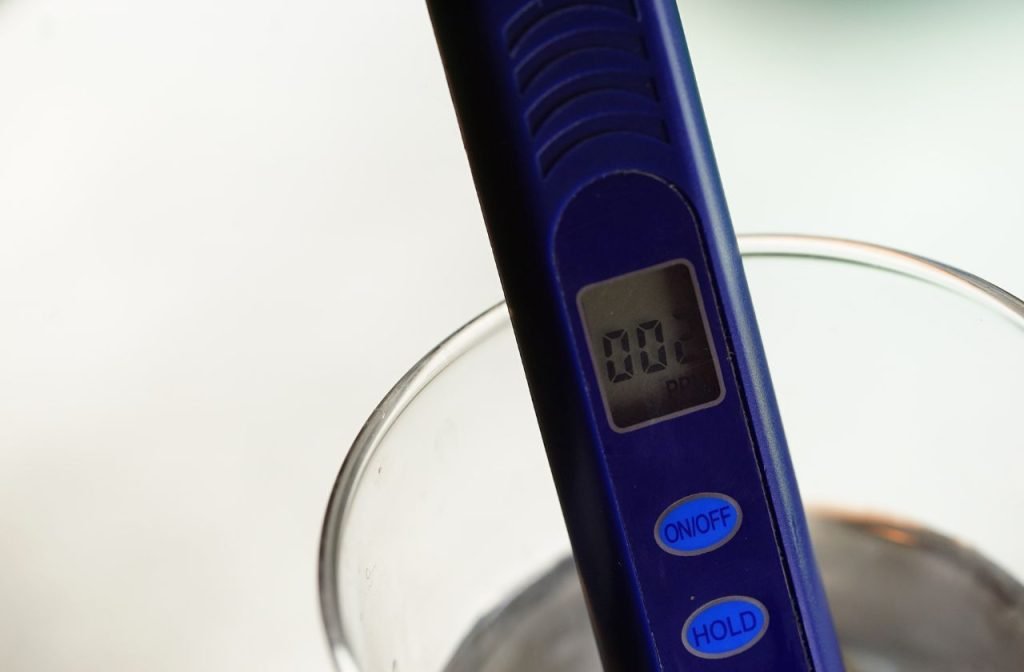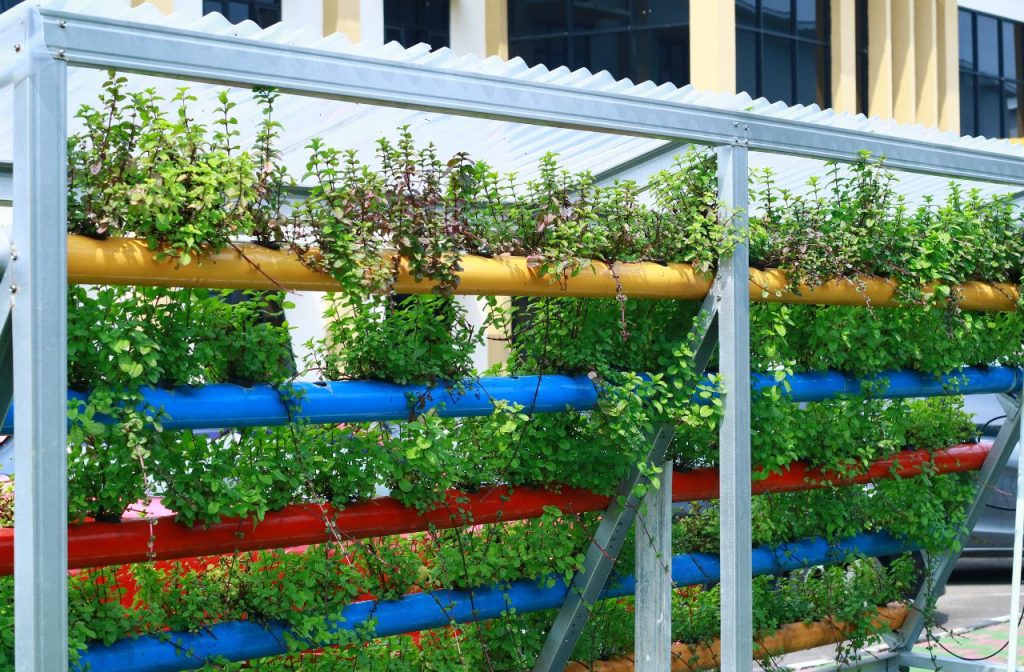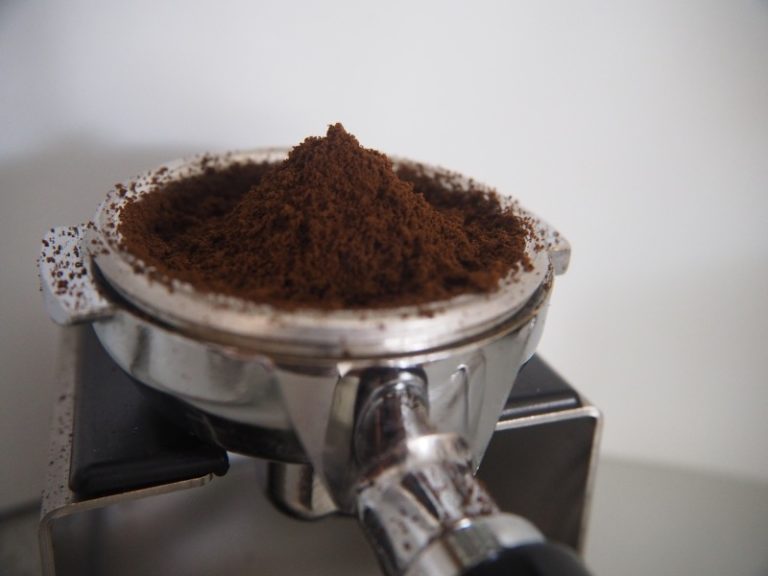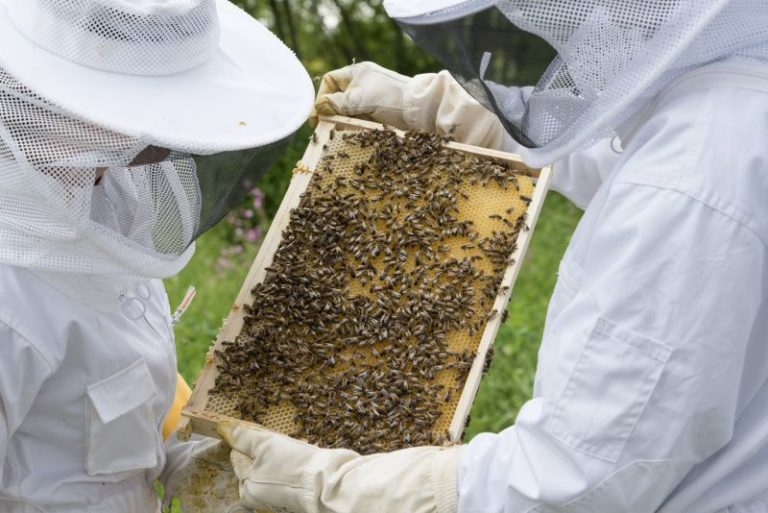What Is EC In Hydroponics?
I get commissions for purchases made through links in this post. View our Affiliate Disclaimer.
Hydroponic growers must closely monitor the growing environment to ensure the plants have ideal conditions to maximize production. EC is one of those metrics that hydroponic growers must become familiar with to understand the plants growing conditions in the system. What is EC, and how does it relate to hydroponic growing?
EC in hydroponics is a measure of the Electrical Conductivity of the nutrient solution and gives an indication of the density of the dissolved nutrients in the water.
Additional Essential Homestead Resources
✅ Medicinal Garden Kit - Grow medicine in your garden! A collection of seeds to get you started.
✅ Homesteaders Handbook - A printed book that covers all the basics for homesteaders.
✅ The Self-Sufficient Backyard - This book is an excellent resource for self-sufficiency on 1/4 acre!
✅ Into The Wild Survival Pack - Learn foundational survival skills every homesteader should know!
In this article, we will explore EC (Electrical Conductivity) in hydroponics and how it plays a crucial role in ensuring the success of your plants. Whether you’re a seasoned hydroponics enthusiast or just starting out on your journey, understanding EC is essential for maintaining optimal nutrient levels and maximizing plant growth.
What Is EC And How Does It Relate To Hydroponics?
When it comes to hydroponics, EC is a fundamental concept that refers to the ability of a solution to conduct electricity. In simpler terms, it measures the concentration of dissolved salts, or nutrients, in your hydroponic solution.
By monitoring EC levels, you can ensure that your plants are receiving the right amount of nutrients they need to thrive. Just like humans need a balanced diet to stay healthy, plants require a precise combination of minerals and nutrients to grow vigorously. By understanding and managing EC, you take control of this vital aspect of hydroponics, giving your plants the best chance to flourish in their hydroponic environment.
EC stands for electrical conductivity, and it’s a crucial measurement technique used in hydroponics to ensure optimal nutrient uptake for plants. In simple terms, EC measures the ability of a solution to conduct electricity, which directly correlates to the concentration of dissolved salts or nutrients in the water.
By monitoring EC levels, hydroponic growers can accurately assess the nutrient strength of their solution, allowing them to make necessary adjustments for optimal plant growth.
What The EC Reading Reveals About Your Nutrient Solution
Measuring EC in hydroponics involves the use of a handheld EC meter. This device works by passing a small electrical current through the water sample, and the meter then measures the resistance of the solution to this current.
The higher the EC reading, the greater the concentration of dissolved salts in the water. By regularly monitoring EC levels, hydroponic growers can ensure that their plants are receiving the right amount of nutrients.
This is important because if the EC is too high, it can lead to nutrient burn, where the plant’s roots are overwhelmed with excessive nutrients. On the other hand, if the EC is too low, the plants may suffer from nutrient deficiencies, resulting in stunted growth and poor yields.
Optimizing nutrient uptake is a critical aspect of hydroponic gardening, and EC measurement plays a vital role in achieving this goal. By maintaining the appropriate EC levels, growers can ensure that the plants receive a balanced and adequate supply of nutrients.
This allows the plants to absorb the necessary elements for healthy growth, leading to robust plants and abundant yields.
Additionally, monitoring EC levels enables growers to identify any fluctuations or imbalances in nutrient concentrations, allowing them to make timely adjustments and prevent potential nutrient deficiencies or toxicities.
Ultimately, understanding and utilizing EC measurement techniques in hydroponics is essential for achieving optimal plant health and maximizing crop yields.
The Importance Of Monitoring Nutrient Levels In Hydroponics
Monitoring nutrient levels is of utmost importance in hydroponics because it allows you to maintain the optimal nutrient balance for your plants’ growth and development.
By regularly checking the EC (electrical conductivity) of your nutrient solution, you can make adjustments to ensure that your plants are receiving the right amount of nutrients they need to thrive.
Optimizing nutrient absorption is another crucial aspect of hydroponic growing. Plants in a hydroponic system rely solely on the nutrient solution for their nutritional needs, so it’s essential to ensure that they can absorb these nutrients efficiently.
Maintaining the right nutrient balance can enhance nutrient absorption and promote healthy plant growth. This involves adjusting the nutrient solution’s EC based on the plant’s growth stage and specific nutrient requirements.
With this knowledge, you can confidently provide your plants with the perfect nutrient balance they need, fostering their growth and ensuring a bountiful harvest. So, keep a close eye on your nutrient levels and watch your hydroponic garden flourish.
How To Measure EC In Hydroponics
You’ll need to use an EC meter to measure EC in hydroponics. This device measures the nutrient solution’s electrical conductivity, providing insight into the overall nutrient levels.
Understanding EC readings is crucial because it allows you to adjust the nutrient solution accordingly, ensuring optimal growth and health of your hydroponic plants.
Using An EC Meter
Using an EC meter allows you to accurately measure the electrical conductivity of your hydroponic solution, providing valuable insights into the nutrient levels and overall health of your plants. EC meters are essential tools for hydroponic growers as they help monitor the concentration of dissolved salts in the nutrient solution.
By measuring the electrical conductivity, you can determine if the nutrient levels are too high or too low, ensuring that your plants receive the optimal amount of nutrients for healthy growth.
To use an EC meter, you first need to calibrate it. Calibration techniques may vary depending on the specific model of the meter, but generally, you will need to use a calibration solution with a known electrical conductivity value. By adjusting the meter to match the value of the calibration solution, you can ensure accurate readings.
Once the meter is calibrated, you can dip the probe into the hydroponic solution and wait for the reading to stabilize. The meter will display the electrical conductivity in terms of millisiemens per centimeter (mS/cm) or micro siemens per centimeter (μS/cm).
It is worth noting that some EC meters will display the EC reading differently. For example, some may display a 1.8 mS/cm reading as 1800.
By regularly measuring the EC of your hydroponic solution, you can make necessary adjustments to maintain the ideal nutrient levels for your plants, promoting healthy growth and maximizing yields.
Understanding EC Readings

As you dip the probe of the EC meter into your nutrient solution, a number appears on the screen, indicating the electrical conductivity and giving you a clear picture of the nutrient concentration in your hydroponic system. Understanding EC measurements is crucial for optimizing nutrient solutions and ensuring the health and growth of your plants.
Electrical conductivity (EC) measures a substance’s ability to conduct an electric current. In hydroponics, EC readings are used to determine the concentration of dissolved salts in the nutrient solution.
The higher the EC reading, the higher the concentration of nutrients in the solution. By monitoring and adjusting the EC levels, you can ensure that your plants receive the right nutrients for optimal growth.
To better understand the relationship between EC readings and nutrient concentration, let’s take a look at the following table:
| EC Reading | Nutrient Concentration |
| Low | Insufficient |
| Medium | Optimal |
| High | Excessive |
You can make informed decisions about adjusting your nutrient solution by analyzing the EC readings and comparing them to the desired nutrient concentration.
For example, if the EC reading is too low, it indicates that the nutrient concentration is insufficient, and you may need to add more nutrients to the solution. On the other hand, if the EC reading is too high, it suggests that the nutrient concentration is excessive, and you may need to dilute the solution with water.
Understanding EC readings is an essential skill for any hydroponic gardener. By optimizing your nutrient solutions based on these measurements, you can provide your plants with the ideal amount of nutrients for healthy and vigorous growth.
Interpreting EC Readings
When interpreting EC readings in hydroponics, you’ll need to understand the electrical conductivity of the nutrient solution. EC, or electrical conductivity, is a measure of the ability of a solution to conduct an electrical current.
In hydroponics, EC readings provide valuable information about the nutrient concentration in the solution. By interpreting EC data, you can optimize your nutrient solutions and ensure that your plants are receiving the appropriate levels of nutrients for healthy growth.
To make the interpretation of EC readings more enjoyable and relatable, here are four key points to keep in mind:
- Know the optimal range: Different plants have different nutrient requirements, and their optimal EC ranges may vary. It is essential to research and understand the specific EC range suitable for the plants you are growing. This will help you determine whether your nutrient solution is too concentrated or too diluted.
- Monitor changes over time: EC readings can fluctuate throughout the growth cycle of your plants. By regularly monitoring and interpreting these readings, you can identify trends and make necessary adjustments to the nutrient solution. This allows you to provide a consistent and optimal environment for your plants to thrive.
- Consider other factors: While EC readings are valuable, it is important to consider other factors that can influence the nutrient uptake of your plants. Factors such as pH levels, temperature, and humidity can affect nutrient availability and absorption. By taking a holistic approach and considering these factors, you can fine-tune your nutrient solution to maximize plant growth.
- Seek guidance from experts: Interpreting EC readings can sometimes be complex, especially for beginners. If you’re unsure about the optimal range or how to adjust your nutrient solution based on EC data, don’t hesitate to seek guidance from experienced hydroponic growers or agronomists. They can provide valuable insights and help you optimize your nutrient solution for the best possible results.
By understanding and interpreting EC readings in hydroponics, you can ensure that your plants receive the right amount of nutrients for optimal growth. Regular monitoring, consideration of other factors, and seeking guidance when needed will help you fine-tune your nutrient solution and create an ideal environment for your plants to thrive.
Factors That Affect EC in Hydroponics
Now that you understand how to interpret EC readings in hydroponics let’s dive into the factors that can affect EC in your hydroponic system. These factors play a crucial role in optimizing nutrient absorption and ensuring that your plants receive the right amount of nutrients for healthy growth.
One of the main factors that can affect EC is the concentration of nutrients in your hydroponic solution. If the nutrient concentration is too high, it can lead to nutrient burn, where the plants are unable to absorb all the nutrients, resulting in leaf damage.
On the other hand, if the nutrient concentration is too low, the plants may not receive enough essential nutrients, leading to nutrient deficiencies and stunted growth. It’s important to regularly monitor and adjust the nutrient concentration to maintain an optimal EC level for your specific crop.
Another factor that can impact EC is the pH level of your nutrient solution. pH is a measure of how acidic or alkaline the solution is. When the pH level is too high or too low, it can affect nutrient availability and absorption.
Most plants prefer a slightly acidic pH range of around 5.5 to 6.5. By maintaining the appropriate pH level, you can ensure that the nutrients in your solution remain in a form that’s easily absorbed by the plants.
Temperature is also a significant factor that can affect EC in hydroponics. Higher temperatures can increase the rate of nutrient uptake by the plants, leading to a higher EC.
Conversely, lower temperatures can slow down nutrient absorption, resulting in a lower EC. It’s important to keep your hydroponic system within the optimal temperature range for your specific crop to maximize nutrient absorption and overall plant health.
By understanding and managing these factors, you can optimize your nutrient solutions and ensure that your plants are receiving the right amount of nutrients.
Remember to regularly monitor and adjust the nutrient concentration, maintain the appropriate pH level, and control the temperature to maintain an optimal EC level for your hydroponic system. With these factors in check, you’ll be well on your way to successful hydroponic gardening.
Troubleshooting EC Issues in Hydroponics

It’s important to monitor and maintain the electrical conductivity (EC) levels in hydroponics to ensure optimal plant growth.
When faced with high or low EC levels, it’s crucial to identify the root cause and take corrective measures.
By understanding the factors that can cause fluctuations in EC levels, such as nutrient imbalances or equipment malfunctions, you can effectively address any issues that arise and maintain a stable and healthy growing environment for your plants.
Identifying and Correcting High or Low EC Levels
To identify and correct high or low EC levels in your hydroponic system, you need to pay close attention to the electrical conductivity of the nutrient solution. High EC levels can indicate an excessive concentration of nutrients in the solution, which can lead to nutrient burn and hinder plant growth.
On the other hand, low EC levels may indicate a lack of nutrients, which can result in nutrient deficiencies and stunted plant growth.
When identifying the causes of high EC levels, you can start by checking the concentration of your nutrient solution. Ensure that you’re not adding too much fertilizer, as this can cause an imbalance in the EC levels. It’s also important to monitor the pH levels, as high pH can lead to increased EC readings.
Additionally, check for any accumulation of salts or mineral deposits in your system, as these can contribute to high EC levels. To correct imbalances, you can dilute the nutrient solution with water to lower the EC levels.
Flushing the system with clean water can also help remove excess salts and minerals. Adjusting the pH to the appropriate range can further help in correcting high EC levels.
In the case of low EC levels, the first step is to ensure that you’re providing enough nutrients to the plants. Check the nutrient solution concentration and make sure it’s within the recommended range for your specific crop. It’s also important to check the pH levels, as low pH can affect nutrient uptake and result in low EC readings.
Another possible cause of low EC levels is poor nutrient uptake by the plants. This can be caused by root damage, inadequate root development, or improper watering practices. To correct imbalances, you can increase the concentration of the nutrient solution by adding more nutrients to the water.
Addressing EC Fluctuations
Don’t you just love when your nutrient solution decides to play a little game of ‘up and down’ with its conductivity levels? Fluctuations in EC (electrical conductivity) can be frustrating and challenging to address in hydroponics. However, it is crucial to address these issues promptly to maintain optimal EC levels for your plants’ growth and overall health.
To effectively address EC fluctuations, it is essential to identify the cause of the issue. Various factors, including changes in temperature, pH levels, nutrient concentration, and water quality, can cause fluctuations.
Once you have identified the potential cause, you can take the necessary steps to rectify the situation and maintain optimal EC levels. One way to address EC fluctuations is by adjusting the nutrient concentration in your solution.
By monitoring and adjusting the nutrient levels regularly, you can ensure that your plants receive the appropriate amount of nutrients for healthy growth.
Another important aspect to consider is water quality. Impurities in the water can affect the EC levels. Using a high-quality water source or implementing a water purification system can help maintain stable EC levels.
A quick reference table can help visualize the steps to address EC fluctuations:
| Steps to Address EC Fluctuations | |
| 1 | Identify the cause of the fluctuation. |
| 2 | Adjust nutrient concentration accordingly. |
| 3 | Monitor and adjust water quality. |
| 4 | Regularly test and measure EC levels. |
Following these steps and promptly addressing EC fluctuations can help you maintain optimal EC levels in your hydroponic system. This will promote healthy plant growth and ensure that your plants receive the right amount of nutrients for thriving in a hydroponic environment.
Remember, consistency and attention to detail are key in addressing EC issues and creating an ideal growing environment for your plants.
Advanced Techniques for EC Management in Hydroponics
Contrary to popular belief, utilizing advanced techniques for EC management in hydroponics can significantly enhance plant growth and yield. These techniques go beyond basic nutrient management and allow for precise control of the hydroponic solution’s electrical conductivity (EC) levels.
By implementing these advanced techniques, you can ensure that your plants receive the optimal nutrient concentration, leading to healthier and more productive growth.
Here are some advanced techniques for EC management in hydroponics:
- Automated EC Monitoring: Installing a sensor system that continuously measures the EC levels in the hydroponic solution can provide real-time data for precise adjustments. This level of automation ensures that your plants are receiving the ideal nutrient concentration at all times.
- Dynamic Nutrient Formulations: Instead of using a fixed nutrient solution, consider using dynamic formulations that adjust the nutrient concentration based on the growth stage of the plants. This technique ensures that the plants receive the right balance of nutrients as they progress through different growth phases.
- Recirculating Systems: Implementing a recirculating system allows for the reuse of the hydroponic solution, reducing the need for constant nutrient replenishment. By recirculating the solution, you can maintain a stable EC level and minimize fluctuations that can negatively impact plant growth.
- Data Analysis and Optimization: Leveraging data analysis tools can help identify patterns and trends in EC fluctuations. By analyzing this data, you can optimize your nutrient management strategies and make informed decisions to improve plant growth and yield.
Adopting these advanced techniques for EC management in hydroponics can take your plant cultivation to the next level. Not only will you achieve healthier and more productive growth, but you’ll also become part of a community of growers who are dedicated to pushing the boundaries of hydroponic cultivation.
Ideal EC Readings For Hydroponic Vegetables
Most plants, including food crops, have an ideal or optimal EC range within which they grow to their best potential. The following table shows the ideal EC range for some common hydroponic crops.
| Vegetable | Ideal EC (mS/cm) |
| Lettuce | 0.8 – 1.2 |
| Parsley | 1.0 – 1.8 |
| Spinach | 1.5 – 2.0 |
| Tomato | 2.0 – 2.5 |
| Cucumber | 1.5 – 2.0 |
| Pepper | 1.5 – 2.5 |
| Basil | 1.5 – 2.0 |
| Strawberry | 1.0 – 1.5 |
| Zucchini | 2.0 – 2.5 |
| Eggplant | 2.5 – 3.0 |
In general, leafy greens and herbs prefer a lower EC, typically between 0.8 – 1.5 mS/cm. Fruiting vegetables like tomatoes, peppers, and cucumbers usually prefer a higher EC, typically between 2.0 – 3.0 mS/cm.
Vegetables can be grouped according to the EC range they prefer, allowing these vegetables to be grown in the same hydroponic systems with the same EC range.
| Vegetables | EC (mS/cm) Range |
| Chard, Kale, Radish, Beetroot, Carrots, Celery | 1.8 to 2.5 |
| Mint, Chives | 1.2 to 1.8 |
| Arugula, Mustard Greens, Collard Greens, Bok Choy | 1.5 to 2.0 |
| Onion, Garlic, Leeks | 1.5 to 2.5 |
| Broccoli, Cauliflower, Brussels Sprouts, Cabbage | 2.0 to 2.5 |
Please note that these are general ranges, and the optimal EC can vary depending on specific varieties and growth conditions. It’s always a good idea to start at the lower end of the range and adjust based on the plant’s response.
EC in Hydroponics FAQs
I have compiled a list of the most frequently asked questions I get regarding using an EC meter and interpreting the results.
Can I use the same EC meter for different types of hydroponic systems?
Yes, you can use the same EC meter for different types of hydroponic systems. However, it is important to rinse off the EC meter probes with fresh water before using it in a different hydroponic system.
What are common signs of nutrient imbalances detected through EC readings?
To detect nutrient imbalances in hydroponics, EC measurements are crucial. By regularly monitoring EC levels, you can identify signs like stunted growth, yellowing leaves, or decreased fruit production. Maintaining proper nutrient balance is essential for healthy plant growth.
Is it necessary to adjust the pH levels of the nutrient solution when monitoring EC?
When monitoring EC levels in hydroponics, it is crucial to adjust the pH levels of the nutrient solution. Just like a conductor fine-tuning an orchestra, pH balance ensures optimal nutrient absorption and plant growth.
How often should I measure EC levels in a hydroponic system?
Measure EC levels in a hydroponic system at least once a week to monitor nutrient imbalances. Factors like temperature, pH, and nutrient concentration can affect EC levels. Imbalances can impact plant growth within a few days. I prefer to check my EC levels every second day to identify problems early.
Conclusion
Understanding EC in hydroponics is crucial for maintaining optimal nutrient levels and ensuring the success of your hydroponic system. By monitoring and managing EC levels, you can ensure that your plants receive the nutrients they need to thrive and grow.
Interpreting EC readings allows you to identify any potential issues or imbalances in your hydroponic system.
By paying attention to factors that affect EC, such as temperature, pH levels, and nutrient concentrations, you can troubleshoot any problems and make necessary adjustments to maintain optimal conditions.
EC in hydroponics is not just a measurement of conductivity but a symbol of the intricate relationship between plants and their growing environment. By understanding, monitoring, and managing EC levels, you hold the key to unlocking the full potential of your hydroponic system and cultivating healthy, thriving plants.
Get more posts like this
Subscribe to our mailing list and get interesting homesteading and green living info and updates to your email inbox.
Thank you for subscribing.
Something went wrong.







